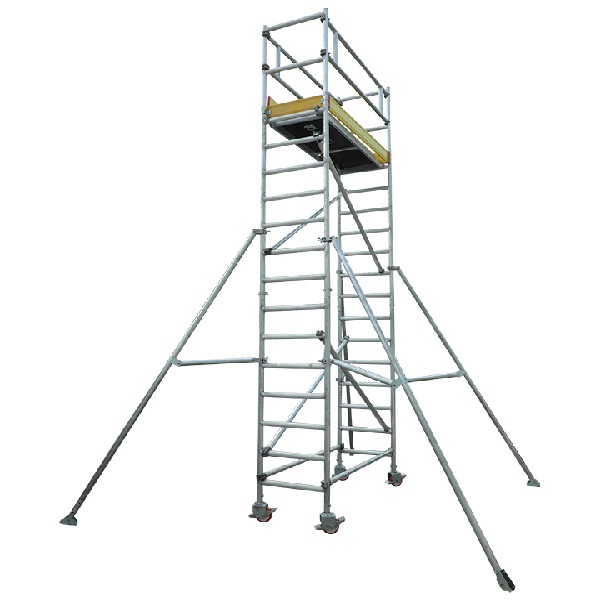When it comes to construction, maintenance, or renovation projects in tight or confined spaces, traditional scaffolding may not always be suitable. This is where narrow scaffolds come into play, offering versatile and efficient solutions for accessing elevated areas in narrow or restricted spaces. Whether you're working in narrow hallways, stairwells, or tight corners, narrow scaffolds provide the stability and accessibility needed to get the job done safely and effectively. Let's explore the world of narrow scaffold systems, their benefits, applications, and why they are essential for projects in compact environments.
Understanding Narrow Scaffold Systems:
Narrow scaffold, also known as compact or slimline scaffolds, are specially designed to fit into tight spaces where standard scaffolding cannot reach. These systems are narrower in width, making them ideal for navigating through narrow doorways, corridors, staircases, and other confined areas. Despite their compact size, narrow scaffolds offer the same level of stability and safety as traditional scaffolding, ensuring that workers can perform their tasks with confidence.
Key Features and Components of Narrow Scaffold Systems:
Slim Profile: The most distinguishing feature of narrow scaffolds is their slim profile. They are typically designed to be narrower than standard scaffolding, allowing them to fit through tight spaces without compromising stability.
Adjustable Heights: Like traditional scaffolds, narrow scaffold systems often come with adjustable height options. This allows workers to customize the scaffold's height to suit the specific requirements of the task at hand.
Platform: Narrow scaffolds are equipped with a sturdy platform where workers can stand and perform their tasks. The platform is usually made of non-slip material for added safety.
Guardrails: To ensure worker safety, narrow scaffolds are fitted with guardrails on all open sides of the platform. These guardrails prevent accidental falls and provide a secure working environment.
Lockable Casters: Many narrow scaffold systems come with lockable casters or wheels. These allow for easy mobility when the scaffold needs to be moved, and the ability to lock the scaffold in place for stability during work.
Compact Storage: When not in use, narrow scaffold systems can be easily disassembled and stored in compact spaces. This makes them ideal for construction sites, warehouses, or facilities with limited storage space.
Benefits of Using Narrow Scaffold Systems:
Access to Confined Areas: The primary benefit of narrow scaffolds is their ability to access areas that are otherwise difficult to reach with standard scaffolding. This includes narrow hallways, staircases, and spaces with limited clearance.
Increased Maneuverability: Narrow scaffold systems are highly maneuverable due to their slim design. Workers can easily navigate through tight spaces and around obstacles to reach their work areas.
Improved Efficiency: With easy access to confined areas, workers can complete tasks more efficiently without the need for time-consuming setups or dismantling of traditional scaffolding.
Enhanced Safety: Despite their compact size, narrow scaffold systems prioritize safety with features such as guardrails, non-slip platforms, and lockable casters. This ensures a secure working environment for workers at elevated heights.
Versatility: Narrow scaffolds are versatile and suitable for a wide range of applications. Whether it's painting, plastering, electrical work, or maintenance tasks, these systems provide a stable platform for various trades.
Cost-Effective: Narrow scaffold systems are a cost-effective solution for projects in compact spaces. They eliminate the need for larger, more expensive scaffolding setups that may not be practical for confined areas.
Common Applications of Narrow Scaffold Systems:
Interior Renovations: Narrow scaffolds are ideal for interior renovation projects in homes, offices, or commercial spaces. They allow workers to access ceilings, walls, and other elevated areas in tight spaces.
Building Maintenance: When performing maintenance tasks such as painting, repairs, or installations in narrow corridors or stairwells, narrow scaffolds provide a safe and stable platform.
Retail Environments: In retail settings with narrow aisles or display areas, narrow scaffold systems are used for restocking, lighting installations, or general maintenance.
Industrial Facilities: Compact scaffolds are essential in industrial settings where space is limited. They are used for equipment maintenance, inspections, and repairs in confined areas.
Event Setup: For events held in venues with narrow access points, such as theaters or convention centers, narrow scaffolds are used for stage setup, lighting installations, and rigging.
Safety Tips for Working with Narrow Scaffold Systems:
Proper Training: Ensure that workers are trained in the proper assembly, use, and dismantling of narrow scaffold systems.
Weight Capacity: Always adhere to the manufacturer's weight capacity guidelines for the scaffold. Overloading can compromise stability.
Guardrails: Ensure that guardrails are properly installed and used at all times when working on the platform.
Locking Casters: When the scaffold is in use, lock the casters to prevent accidental movement.
Inspect Regularly: Before each use, inspect the scaffold for any damage, loose components, or defects that could affect safety.
Use Personal Protective Equipment (PPE): Workers should wear appropriate PPE such as hard hats, non-slip footwear, and fall protection gear when working on a narrow scaffold.
Conclusion:
Narrow scaffold systems are indispensable tools for projects in compact or confined spaces. With their slim profile, maneuverability, and safety features, they provide access to elevated areas where traditional scaffolding cannot reach. Whether it's interior renovations, building maintenance, retail setups, or industrial tasks, narrow scaffolds offer a stable and efficient platform for workers. By choosing a reputable manufacturer and following safety guidelines, construction crews, maintenance workers, and tradespeople can safely and effectively complete their tasks in tight spaces with the help of narrow scaffold systems.
For more info. visit us:





Comments